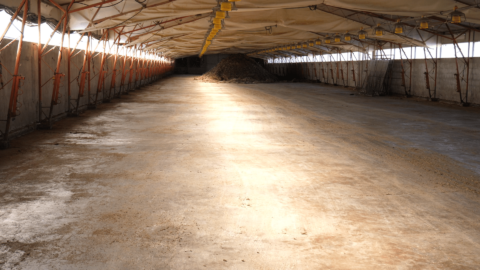Feature
The Sneaky Way Even Meat Lovers Can Lessen Their Climate Impact
Food•6 min read
Reported
A new EU government report warns of an impending uptick in avian flu outbreaks, especially in areas with a high concentration of factory farms.


Words by Francesco deAugustinis
A report from the European Food Safety Authority warns new avian flu outbreaks on poultry operations could increase again in the next few months. The rising risk comes as wild birds begin their annual migration to areas with high numbers of industrial poultry and egg farms. The report suggests these operations are at especially high risk — yet the poultry industry is pushing for vaccines as a solution rather than shut down factory farms packed with 20 thousand birds at a time.
The outbreak is already responsible for over 58.3 million poultry losses in Europe — with particular losses to ducks, turkeys and chickens — and billions in public funding.
EFSA regulator Francesca Baldinelli calls the current epidemic “certainly the most important and devastating epidemic we have observed in Europe” — both in terms of sheer numbers and geographic extent, as cases have been found “from the extreme North of Europe to the extreme South of the Iberian Peninsula.”
In the past, says Gert-Jan Oplaat, president of the Association of Poultry Processors and Poultry Trade in the EU countries, avian flu might spread from November to February. “This is the first time it’s almost endemic,” he says.
The agency has been closely monitoring avian flu since 2016, at the time the largest ever outbreak recorded in the European Union. Since then, says Baldinelli, there have been epidemics every year since 2020. “Why we are increasingly seeing very important epidemics of avian flu is a question that is very difficult to answer.”
Yet evidence from EFSA’s own reporting suggests the excessive density of intensive poultry farms is at the root of the problem. In a report published in June, the EU body asked to activate “a medium-term strategy” to reduce the density of livestock farming in high-production areas. According to the document, during late spring and early summer months, 86 percent of poultry outbreaks were due to farm to farm transmission.
According to Baldinelli, most of the spread occurred in certain regions, “especially in South-East France, in the foie gras industry, but also in North-East Italy, with turkeys.” Baldinelli also points to outbreaks in Hungary where both duck for foie gras and turkeys are farmed.
For now, the livestock industry remains reluctant to adopt strategies to reduce densities in production areas, citing financial loss. “I think it’s better that we keep working on vaccination,” the poultry association’s Oplaat says. “It’s very hard to replace a farm,” he adds. “It costs a lot of money.”
If the farmer detects a positive case, says Oplaat, “he has to phone the veterinarian, that’s the law. If they find something, they immediately block the farm and cull the birds.” Oplaat worries about the public response. “We are at the point that it’s very hard for people and society to accept that we kill so many birds,” he says.
The massive slaughter of millions of farmed animals comes at a steep cost. In France, according to Jean-Michel Schaeffer, president of the French Confederation of Poultry, in 2022 “the estimated impact for the whole industry was enormous, we estimated it at 2 billion euros.”
These losses have been largely compensated with public funds. According to data provided by email from a representative of the EU Commission, Europe allocated around 400 million euros between October 2021 and September 2022 for member states to refund economic losses suffered by poultry companies.
The amount paid out varies by country. According to government data, 21.8 million animals have been slaughtered in France since the beginning of the epidemic (August 2021), leading the government to set aside 1.1 billion euros for French companies. In Italy, where 15 million animals were culled in 2022, representatives of the poultry industry said that government refunds amounted to almost 1 billion Euro. According to the Italian Institute of Services for the Agricultural Food Market, in January 2022 every single turkey culled in Italy was paid between 9 and 20 euros, a broiler chicken around 1.5 euros. The Italian Ministry of Health did not answer our request for official figures.
Since early 2022, researchers have been concerned about spread to humans after an outbreak on a mink farm in Spain.
The virus has continued to mutate, EFSA scientists have observed, becoming capable of infecting previously non-threatened species, such as aquatic birds that nest in Europe in summer, or even several mammals in Europe, the Americas and Asia. In humans, the latest report lists eight detections in recent months in Cambodia, China, Ecuador and Vietnam. In Europe, the document assesses a low risk for the human population, which rises to “low to moderate for occupationally or otherwise exposed people.”
The risk remains uncertain at this time, according to Baldinelli. “Viral strains are circulating, and mutations may emerge that facilitate its adaptation and replication in humans.”